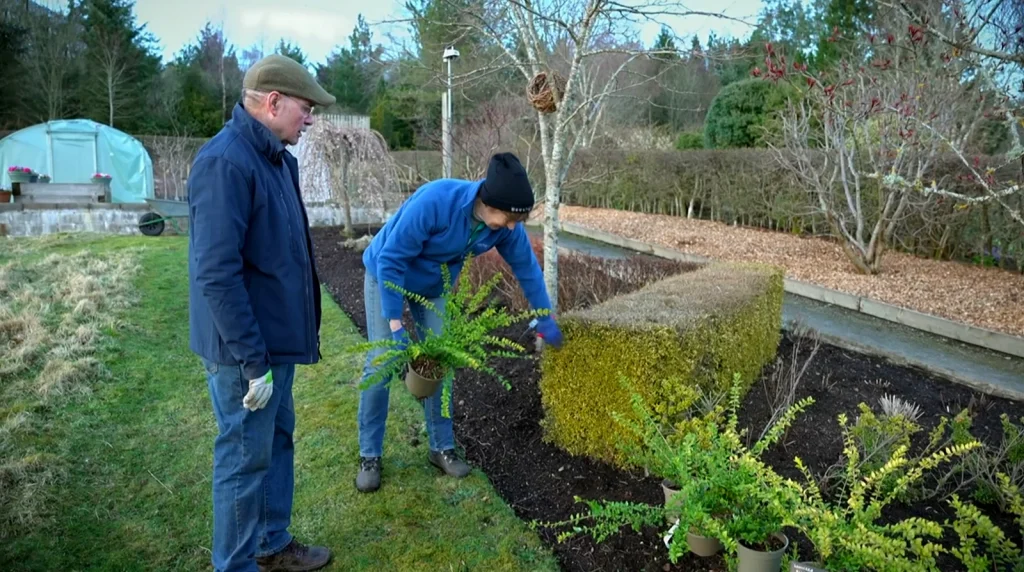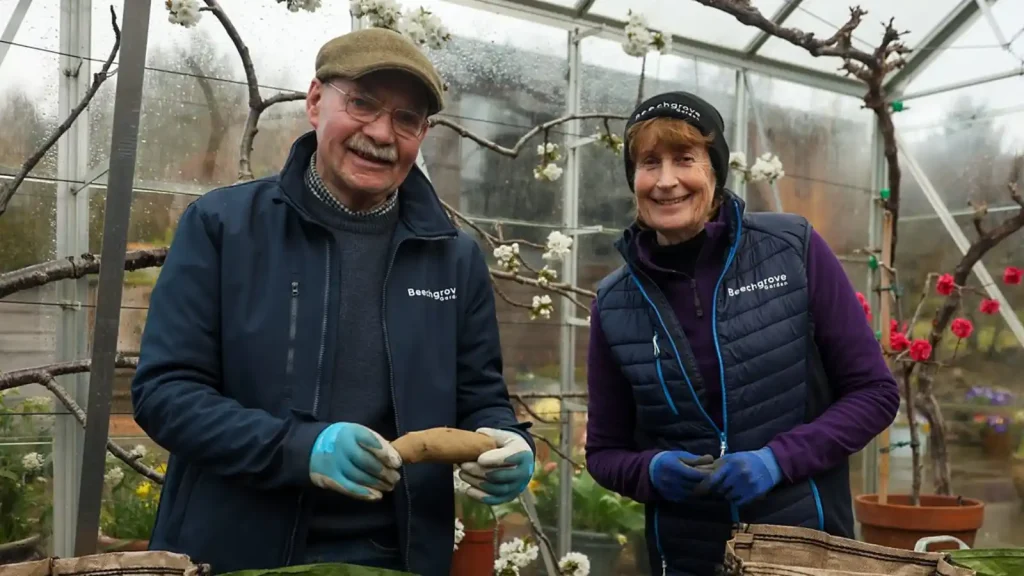In The Beechgrove Garden 2024 episode 12, Brian Cunningham and Carole Baxter delve into the fascinating world of alpine plants. Although these resilient plants are typically found in harsh mountain environments, they also thrive in more accessible settings like the Beechgrove Garden. Brian and Carole share expert tips on cultivating these unique plants, showcasing their versatility and beauty.
Additionally, Brian and Carole revisit an area of the garden they had to replant two years ago due to disease. They had utilized dwarf bamboo and decorative stumps from a fallen alder to create an innovative and attractive new look for the space. In this episode, they evaluate the progress of this transformed area, discussing its current state and future plans. Their insights offer valuable lessons on dealing with plant diseases and creatively reimagining garden spaces.
Carole provides an update on the successional tattie planting, a technique that ensures a continuous harvest of potatoes. She details the progress and shares her observations, offering practical advice for home gardeners looking to maximize their potato yields.
Furthermore, Carole takes us into the 8×6 domestic greenhouse, where she explains the essential tasks that need to be undertaken at this time of year to ensure the best possible results for tomatoes and cucumbers. Her guidance covers everything from planting techniques to maintenance tips, making it easier for viewers to achieve a bountiful greenhouse harvest.
Join us for this informative episode as Brian and Carole share their expertise and passion for gardening, helping you to create a thriving and beautiful garden space of your own. Whether you’re interested in alpine plants, innovative garden design, or optimizing your greenhouse produce, this episode has something for every gardening enthusiast.
Beechgrove Garden 2024 Episode 12 promises to be a treasure trove of gardening wisdom, combining practical advice with inspiring ideas to enhance your gardening experience.
The Beechgrove Garden 2024 episode 12
Discover the Allure of Alpines – Your Guide to Growing Mountain Jewels
The mountains beckon, their peaks whispering secrets of resilience and beauty. Yet, you don’t need to scale treacherous slopes to experience their charm. Alpines, the floral gems of high altitudes, bring the magic of the mountains right to your doorstep. These hardy, vibrant plants, with their enchanting blooms and captivating textures, are like tiny ambassadors of the alpine world, ready to transform your garden into a haven of wonder.
Unveiling the Enchantment of Alpines
Imagine miniature meadows bursting with color, delicate petals unfurling against a backdrop of rugged rocks. Alpines, hailing from regions where the air is crisp and the sun’s embrace is fierce, have evolved to thrive in challenging conditions. This resilience, coupled with their exquisite beauty, makes them an irresistible choice for gardeners seeking something truly special.
Originating in diverse mountainous landscapes across the globe, alpines have adapted to a wide range of environments, from windswept slopes to rocky crevices. Their diversity is astonishing, with countless species and varieties showcasing an array of colors, shapes, and sizes. Whether you’re drawn to the vibrant blues of gentians, the delicate pinks of saxifrages, or the sun-kissed yellows of potentillas, there’s an alpine to capture your heart.
Why Alpines Are Perfect for Your Garden
But alpines are more than just pretty faces. They’re practical too. Their compact size and low-maintenance nature make them perfect for gardens of all sizes, from expansive landscapes to cozy balconies. Alpines are like the chameleons of the plant world, adapting to various soil types and thriving in both sun-drenched spots and shaded corners.
Furthermore, alpines offer year-round interest. While their spring and summer blooms steal the show, many varieties boast attractive foliage that persists through autumn and winter. Some even surprise with vibrant fall colors or delicate winter blooms, ensuring your garden remains a haven of beauty throughout the seasons.
A Symphony of Colors and Textures
Alpines are masters of creating visual harmony. Their compact growth habit and diverse textures, from velvety leaves to spiky foliage, create a tapestry of contrasts that delights the eye. Whether you prefer a riot of color or a more subdued palette, alpines can be combined to create stunning displays.
Imagine a rock garden bursting with vibrant alpines, their jewel-like blooms nestled among weathered stones. Or perhaps a collection of alpine troughs, each a miniature world teeming with life and color. Alpines are versatile performers, equally at home in traditional borders, modern planters, or even cascading over walls.
Cultivating Alpine Magic: Essential Tips for Thriving Plants
Alpines, with their delicate beauty and hardy nature, are a testament to the resilience of nature. However, even these mountain survivors need a little help to flourish in your garden. By understanding their unique needs and providing the right care, you can unlock the secrets to cultivating alpine magic and enjoy a thriving display of these enchanting plants.
Choosing the Right Alpines: Matching Plants to Place
Selecting the right alpines is like assembling a puzzle, each piece contributing to the overall picture of your garden. Consider your garden’s unique conditions, such as sunlight exposure, soil type, and available space. Some alpines bask in full sun, while others prefer the gentle shade of taller companions. Similarly, soil preferences vary, with some alpines thriving in well-draining, gritty soil, while others tolerate slightly more moisture.
Research different alpine varieties and their specific requirements. Look for plants that naturally thrive in your climate and soil conditions. Don’t be afraid to experiment with different combinations, but always prioritize the well-being of your plants by choosing those that are well-suited to your garden’s unique environment.
Creating the Ideal Alpine Haven: Nurturing Nature’s Jewels
Imagine your garden as a miniature mountain range, with peaks and valleys, sunny slopes, and shaded nooks. Alpines thrive in well-draining soil that mimics their natural habitat. Incorporate plenty of grit, gravel, or coarse sand to ensure excess water flows away quickly, preventing root rot.
Sunlight is the lifeblood of alpines. Most varieties crave full sun, but some prefer partial shade. Observe your garden throughout the day to identify areas with different light levels. This will help you position your alpines strategically, ensuring they receive the optimal amount of sunlight for their specific needs.
Planting and Nurturing Your Alpines: A Labor of Love
Planting alpines is like tucking them into bed, ensuring they have everything they need for a restful sleep and a vibrant awakening. Whether you’re planting in the ground or in containers, the key is to provide a well-draining environment. Dig a hole slightly larger than the root ball, gently loosen the roots, and place the plant at the same depth it was growing in its container.
After planting, water your alpines thoroughly, but avoid overwatering. Alpines are drought-tolerant and prefer their soil to dry out slightly between waterings. Mulching with grit or gravel helps to conserve moisture, suppress weeds, and protect the plants’ delicate crowns from rot.
Troubleshooting Common Challenges: Protecting Your Alpine Treasures
Even with the best care, alpines may encounter challenges. Pests like aphids and vine weevils can wreak havoc, while fungal diseases can thrive in damp conditions. Vigilance is key. Regularly inspect your plants for signs of trouble, such as discolored leaves, wilting, or pests.
If you spot any issues, take prompt action. Remove affected leaves, treat with organic pesticides or fungicides if necessary, and adjust your watering practices. Remember, prevention is better than cure. By providing optimal growing conditions and staying vigilant, you can keep your alpines healthy and vibrant for years to come.
Designing with Alpines: Unleash Your Creativity
Alpines are not just plants; they’re living brushstrokes, ready to paint your garden with a symphony of colors and textures. With their diverse forms and growth habits, they offer endless possibilities for creative expression. Whether you’re a seasoned gardener or a novice enthusiast, designing with alpines is an invitation to unleash your imagination and transform your outdoor space into a breathtaking masterpiece.
Rock Gardens in The Beechgrove Garden 2024 episode 12
Imagine a rugged landscape, where weathered rocks rise from the earth, creating a dramatic backdrop for a tapestry of alpine blooms. Rock gardens are the epitome of alpine artistry, mimicking the natural habitats where these resilient plants thrive. By carefully arranging rocks of various sizes and shapes, you can create a multi-dimensional canvas that showcases the unique beauty of each alpine specimen.
The interplay of light and shadow, the textures of stone and foliage, and the vibrant pops of color from alpine flowers create a visual feast for the senses. Rock gardens are not just static displays; they’re dynamic ecosystems, where alpines weave their roots through crevices, creating a sense of harmony and balance.
Container Gardening: Miniature Alpine Wonderlands
Not everyone has the luxury of a sprawling garden, but that doesn’t mean you have to miss out on the alpine enchantment. Container gardening offers a delightful solution, allowing you to create miniature alpine wonderlands in even the smallest of spaces. From terracotta pots to rustic troughs, the possibilities are endless.
Imagine a weathered stone trough overflowing with a vibrant mix of alpines, their delicate blooms cascading over the edges like a waterfall of color. Or perhaps a collection of terracotta pots, each showcasing a different alpine variety, creating a miniature mountain range on your patio. Container gardening allows you to bring the alpine magic closer to home, where you can admire their intricate details and enjoy their captivating fragrance.
Creative Combinations: Mixing and Matching Alpines
Alpines are like social butterflies, thriving in the company of others. By combining different varieties, you can create a tapestry of textures, colors, and forms that will leave visitors in awe. Consider the contrasting foliage of silver-leaved saxifrages and the deep green of sempervivums. Or perhaps the delicate blooms of alpine pinks alongside the bold spikes of penstemons.
The key is to create a harmonious balance, where each plant complements the others without overwhelming them. Experiment with different combinations, playing with heights, textures, and colors. Let your creativity guide you as you create a unique alpine masterpiece that reflects your personal style and taste.
Seasonal Splendor: Alpines Throughout the Year
One of the most enchanting aspects of alpines is their ability to provide year-round interest. While many varieties burst into bloom in spring and summer, others offer stunning foliage or delicate winter flowers. By carefully selecting a diverse range of alpines, you can ensure your garden remains a vibrant tapestry of color and texture throughout the seasons.
Imagine the early spring awakening, as crocuses and snowdrops emerge from the frosty ground, their delicate blooms heralding the arrival of warmer days. As spring progresses, saxifrages, gentians, and primulas take center stage, their vibrant colors painting the landscape with joy. In summer, the alpine meadows come alive with a symphony of blooms, from the fiery reds of dianthus to the soothing blues of campanulas. As autumn approaches, the foliage of many alpines takes on rich hues of gold, orange, and red, creating a final burst of color before winter’s embrace. And even in the depths of winter, some alpines, like the Christmas rose, defy the cold with their delicate blooms, reminding us that beauty can be found in even the harshest of conditions.
F.A.Q. The Beechgrove Garden 2024 episode 12
Q.: What are alpine plants, and why are they significant in gardening?
A.: Alpine plants are resilient species native to mountainous regions, known for their ability to thrive in harsh conditions such as high altitudes and rocky terrains. They are significant in gardening because of their hardiness, low-maintenance requirements, and unique aesthetic appeal. These plants bring a touch of the rugged mountain beauty to gardens, offering a diverse range of colors, shapes, and textures that enhance any garden space.
Q.: How can I successfully cultivate alpine plants in my garden?
A.: To successfully cultivate alpine plants, it is crucial to mimic their natural habitat. This includes providing well-draining soil, ample sunlight, and protection from excessive moisture. Incorporate plenty of grit or gravel into the soil to enhance drainage. Most alpine plants prefer full sun, though some may tolerate partial shade. Regular but moderate watering is essential to avoid waterlogging. Mulching with gravel or coarse sand can help maintain soil conditions and prevent weed growth.
Q.: What steps were taken to replant the diseased area in Beechgrove Garden, and what can we learn from this process?
A.: In Beechgrove Garden, the diseased area was replanted with dwarf bamboo and decorative stumps from a fallen alder, creating an innovative and attractive new look. This process teaches valuable lessons in dealing with plant diseases and creatively redesigning garden spaces. It highlights the importance of selecting disease-resistant plants, using natural elements to enhance garden aesthetics, and continuously monitoring and adapting garden strategies to maintain a healthy environment.
Q.: What are the benefits of successional tattie planting, as practiced by Carole Baxter in Beechgrove Garden?
A.: Successional tattie planting, as practiced by Carole Baxter, ensures a continuous harvest of potatoes throughout the growing season. This method involves planting potatoes at intervals, rather than all at once, which extends the harvest period and optimizes yield. It allows gardeners to enjoy fresh potatoes for a longer duration and reduces the risk of a single crop failure. Additionally, it helps manage pests and diseases by avoiding monoculture.
Q.: What essential tasks should be performed in an 8×6 domestic greenhouse to achieve the best results for tomatoes and cucumbers?
A.: In an 8×6 domestic greenhouse, achieving the best results for tomatoes and cucumbers involves several key tasks. First, ensure proper ventilation to regulate temperature and humidity levels. Use stakes or trellises to support plant growth and improve air circulation. Regularly monitor for pests and diseases, and implement organic control methods as needed. Water consistently but avoid overwatering to prevent root rot. Finally, feed the plants with a balanced fertilizer to promote healthy growth and fruit production.
Q.: What are the main challenges in growing alpine plants, and how can they be mitigated?
A.: The main challenges in growing alpine plants include ensuring proper drainage, preventing waterlogging, and protecting the plants from extreme weather conditions. These can be mitigated by using well-draining soil mixes, incorporating grit or gravel, and choosing appropriate planting sites. In regions with heavy rainfall, raised beds or rock gardens can help improve drainage. Providing shelter from strong winds and using mulch to protect the roots can also enhance the resilience of alpine plants.
Q.: How does the design of rock gardens benefit alpine plants?
A.: Rock gardens are designed to mimic the natural rocky habitats of alpine plants, providing ideal growing conditions. The rocks help improve drainage, prevent soil erosion, and create microclimates that protect plants from extreme temperatures. The varied terrain of a rock garden allows for the cultivation of different alpine species with diverse light and moisture requirements. Additionally, the visual appeal of rock gardens enhances the beauty of alpine plants, creating a harmonious and naturalistic garden feature.
Q.: What are some popular alpine plants suitable for home gardens, and what are their specific care requirements?
A.: Popular alpine plants suitable for home gardens include gentians, saxifrages, and potentillas. Gentians prefer well-drained, slightly acidic soil and full sun to partial shade. Saxifrages thrive in rocky, well-drained soil and require moderate watering. Potentillas are versatile and can grow in various soil types, preferring full sun and well-drained conditions. Each of these plants offers unique colors and textures, adding diversity and interest to garden spaces.
Q.: What are the advantages of container gardening with alpine plants?
A.: Container gardening with alpine plants offers several advantages, including the ability to control soil conditions, drainage, and exposure to sunlight. Containers allow gardeners to create customized microenvironments suited to the specific needs of alpine plants. This method is ideal for small spaces, such as patios or balconies, and provides the flexibility to move plants as needed to optimize growth conditions. Container gardening also simplifies maintenance and pest management, making it easier to care for delicate alpine species.
Q.: How can one maintain year-round interest in a garden using alpine plants?
A.: Maintaining year-round interest in a garden using alpine plants involves selecting a variety of species that offer seasonal blooms and attractive foliage. Many alpine plants have striking foliage that remains vibrant through autumn and winter, while others produce flowers in colder months. By combining plants with different blooming periods and foliage colors, gardeners can ensure continuous visual interest. Incorporating evergreen alpines and those with winter blooms, such as the Christmas rose, can keep the garden lively even in the off-season. Regular care, including pruning and mulching, also helps maintain the health and appearance of alpine plants throughout the year.
Conclusion: Embrace the Alpine Adventure
Your garden is a canvas, and alpines are your palette of colors. With their resilience, adaptability, and captivating beauty, they offer endless possibilities for creative expression. Whether you’re a seasoned gardener or a budding enthusiast, the world of alpines is yours to explore.
Your Journey to Alpine Mastery
From selecting the right varieties to creating the perfect growing conditions, you now possess the knowledge to cultivate alpine magic in your own backyard. Remember, the key is to understand their unique needs and provide the care they crave. With a little patience and dedication, you’ll be rewarded with a thriving display of these mountain jewels.
Inspiration Awaits
As you embark on your alpine gardening journey, let your imagination soar. Picture vibrant rock gardens, miniature alpine wonderlands in containers, and creative combinations that showcase the diversity of these enchanting plants. The possibilities are as limitless as the mountain ranges from which they hail.
Resources and Further Exploration
The world of alpines is vast and ever-evolving. To deepen your knowledge and connect with fellow enthusiasts, consider joining alpine gardening societies, visiting botanical gardens with alpine collections, or exploring online forums and resources. Share your experiences, learn from others, and continue to discover the joy and wonder that alpines bring to the gardening world.
Embrace the alpine adventure, and let these resilient beauties inspire you to create a garden that is truly extraordinary.




